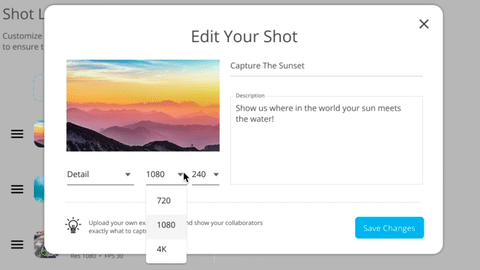The Ultimate Guide to Remote Video Production
Remote Video Production: Unlocking the Power of Authentic Content Creation
Once, and not too long ago to be honest, it was most commonly used as a back-up plan. It was the “cheap” option, used when budget was an issue, deadlines were super-tight, or there was a last minute change to the shoot in question. In the pre-pandemic world, the idea of doing your video production from afar was almost laughable. Why would you want to do that when you can get way better footage in person? Then COVID19 entered the chat. Everything shut down. Film crews were sidelined.
But as we all know, nature abhors a vacuum. So the world looked to remote video production not as a back-up, but as the only viable option to create the content that was still very much in demand by brands and agencies worldwide.
Embracing the Shift: The Rise of Remote Video Production
As you now know, there was an absolute explosion of remote video production. Everyone was doing it. Yes, some went to platforms like Zoom in the early stages of the lockdown but the quality was poor to say the least. While useful for directing people from afar, the video quality itself is not up to par for professional content. As expected, the hunt for high quality remote video production methods was on. Production drop kits were in the mix but while the quality is superior, they’re cumbersome, expensive, and require handholding if the operator is inexperienced.
At the same time, smartphone technology and the accompanying apps continued to advance at a rapid rate, and 5G speeds and Gigabit internet made it quick and easy to upload large files to the cloud in the blink of an eye. Plus, everyone has a smartphone and knows how to use one and we’re all connected to the cloud. And what’s more, there was a growing demand for more authentic, genuine content that was making platforms like TikTok and Instagram so popular.
The result of this perfect storm was that remote video production, with its high-quality remote video recording capabilities, was no longer looked at as an also-ran. Far from it, the combination of superb quality, decreased costs, and the ability to film around the world without ever stepping foot on a plane made this new way of capturing content the preferred way for so many people in the industry. And that brings us to where we are today.
Back to Normal. But Not Back to Business as Usual.
“There’s no going back.” That was pretty much on the minds of everyone as the world opened back up and traditional production methods were compared to remote video production. The pandemic shifted the paradigm, and the industry realized that remote video production was actually a rock star. It’s more efficient than regular film crews. It’s way faster and more affordable than the old methods, which is highly desirable when you’re looking at ever-decreasing budgets. And it has the authenticity the public is craving. In other words, the king is dead… long live the king. Even Frame.io is getting into the remote production space now that they’ve dominated remote collaboration and editing. This is the new norm.
So that’s the back story. Now what? You know remote video production is a killer way to get the content you need, which brands everywhere require more and more of. From fun branded content to workplace culture videos, it’s an exceptional way to get genuine footage. But if you’re not familiar with it, it may seem a little mysterious. Well, let’s pull back the curtain and take you through the process from soup to nuts.
Start With the Technology.
This method of production doesn’t require truckloads of equipment and a large crew to operate it. What you’re looking at is smartphone-based production, and as everyone has one in their pocket you don’t even need to buy that. But, you do need to look into the right apps and software to get the job done. By selecting the best software on the market, you are getting tools that help you leverage the cloud to optimize your remote video productions. One such app, and by all accounts the preferred one for User Generated Content (UGC), is Cinebody. However, there are others to choose from that may or may not be better suited to your production.
Before we get into pre-production, it’s also worth considering how this method differs from the traditional filming techniques you’re more familiar with. There’s no need to hire a production team to execute your vision. But on the flip side, you’re also not getting that level of support you’re used to. In most cases you will be working directly with the person being filmed, which is usually an influencer, brand evangelist, an employee, or just a huge fan of your product or service. If you’re ready for this more streamlined way to get the job done, let’s move into the typical three-step process of any video production.
Pre-production Is Still Required, but It’s a Different Ball Game.
So planning ahead is still crucial of course, but with crowdsourced video you’re going to be doing things a little differently. It starts with who is actually doing the filming, and how much they know about it. Do they need extra support, or are they good to go? If they’re amateurs, which is highly likely with UGC content, consider how you onboard them. Customize the experience, make them feel as special as they are to your project (they’re the filmer and the star), and above all make it fun! This shouldn’t feel like work, especially if you’re asking them to capture footage at a concert or event.
Next up, the shot list. Nail this ahead of time and provide it to your filmers so that they know both what they’re filming, and also how to actually film it. Some apps have a built-in shot list feature which streamlines the process. Provide some handy tips and tricks, a cheat sheet, and whatever else you think can inspire them (without overwhelming them with info). And set a deadline. Productions can crash and burn without a strict timeline, so give dates and times. Open-ended deadlines open you up to a world of delays and problems.
Then it’s time to prep for your remote filming project, and of course this isn’t like a typical film production. You (or the person doing the filming) need to be thinking about battery life, storage, and connectivity to the cloud. It’s all well and good filming incredible footage but if there’s no way to access it you can’t start reviewing and editing the content. That can lead to big delays.
If you’re doing interviews via Zoom, or another conference calling app, take some extra time to set up the shot, and also get to know your subject before you start filming. Build a rapport. Maybe don’t even start with the subject of the piece but some more informal questions about them, their dreams, hobbies, that kind of thing. It’ll get them relaxed and ready for a more natural interview.
The Production Itself: A Less Complicated Affair.
With traditional video productions you’re wrangling crews, equipment, dealing with craft services, and myriad other diversions. Remote video production removes all that hassle, and that gives you more time to focus on the task at hand - getting good footage “in the can.”
If you’re using software that immediately uploads footage as it’s filmed, you can quickly check on what has been captured (even if you’re in another part of the world) and provide feedback in real time. You can even download the footage you like to start editing, which really puts you ahead of the game.
If you don’t have that option, stay on top of your filmers to ensure they capture just what you asked for, and then provide you with that content through the file transfer method(s) you’ve selected. DO NOT let your filmers email or text the footage to you. It will compress and degrade the high-quality footage into something almost unusable, and whenever possible you want to be working with the original files.
And remember to keep on providing feedback as the footage rolls in. You may want a different approach that wasn’t in the original shot list, or you might want to try more concise answers. Do this now, because later is too late.
Post-production Should Now Be a Breeze.
Well, we’re not saying it’s easy, but it’s certainly way more streamlined than working with traditional production methods. For a start, you may have already started editing the footage that came in, IF you have software that instantly transfers it to the cloud. This gives you the ability to do lightning-fast turnarounds. It’s possible your editor is also working remotely, and that too is a game changer. You can select the people you want, wherever they are in the world, and get the job done right. In fact, with remote video production, you’re cutting out a ton of the legwork and can get right into editing quickly and efficiently. This is crucial for those projects that require content in a very timely manner, such as covering a convention, an experiential event, or something newsworthy.
Congratulations! You are now equipped with a foolproof guide to obtaining outstanding content through remote video production. If you haven't experienced this increasingly popular and favored method of capturing footage, it's high time you consider it for your next project. It proves particularly effective for creating compelling employee engagement videos and eliciting genuine responses from your brand's enthusiastic fan base. Not only does it save time, but it is also significantly more cost-effective compared to traditional filming, providing you with remarkable value for your investment. Remote video production has established its presence and is undoubtedly set to become the go-to approach for capturing user-generated content in the future.




